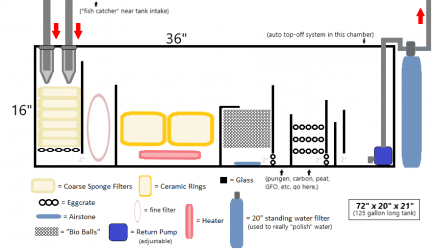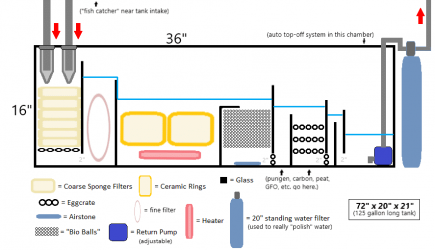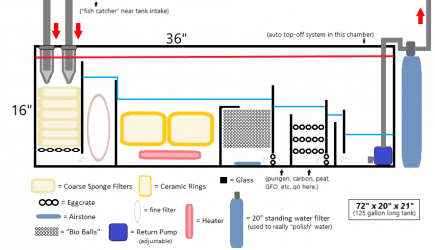You don't need a refugium on a freshwater tank with plants. The refugium is normally used to grow macro algae in marine tanks to help use nutrients and for plankton and small crustaceans to live and breed. It's pointless in a freshwater tank with plants. If you had a Rift Lake cichlid tank, then you can have a refugium to grow plants in.
------------------
The heater should be in an area like the refugium so there is a constant depth of water. The area with the return pump will vary over time, and as water evaporates the level in the pump section will get shallower. This will screw up the heater.
------------------
No point having bio-balls if you have sponges.
No point having ceramic rings if you have bio-balls or sponges.
Sponges do the same thing as bio balls and ceramic beads/ rings and the sponges trap debris too. Just use sponges and save your money.
Don't need egg crate in the narrow section near the pump.
------------------
Don't need a standing water filter on the outlet of a sump. The sump is the filter.
------------------
On a freshwater tank, get an aquarium that is at least half the length of the main tank x the same width and about 18 inches high. Put it on a double tier stand underneath the main tank.
Make sure there is at least 12 inches of space above the sump to get things in and out of it. Lots of people make big sumps and only have a few inches of space above it and can't get into it to clean.
Have cover glasses on the sump to reduce evaporation and help stop mould growing on the stand.
Make sure the sump is big enough to hold the extra water from the main tank during a power failure.
----------
The tank water drains into a compartment that has some sponges and white filter matt on top of the sponges. The white filter matt gets taken outside and washed once a week or whenever it gets dirty. The sponges can be taken out once a month and washed out in a bucket of tank water.
Don't make the sponges too thick because they can be hard to clean when big and or thick.
The rest of the tank can be the reservoir and house the heater and return pump. If you want to put another baffle in near the pump that is fine. You can have a section for carbon if you like but it isn't normally needed unless you are trying to remove chemicals or heavy metals.
Thanks for the feedback.
1 - You mention not needing a refugium, but I've read MANY articles and forums now where people say a freshwater refugium on a heavily stocked & planted tank will absolutely be beneficial. Why do you feel it will not?
2 - The space with the heater and return pump will ALWAYS be within 1mm of it's desired height. I have a bunch of unused float switches (moving countries and leaving behind 4 aquariums... so I already have all the media & such), and I've already planned the reservoir in the cabinet space I'm having built. I have auto-top off systems in place for all of my tanks, always. I hate "topping off" and I'm too OCD for it to drop "a bit" and not go unnoticed. Knowing that, do you still feel the heather should be in a different section? I was going to place it in between 2 of the "thinly spaced" baffles, but wasn't sure if being against he glass all the time would cause problems or not.
3 - Yes, good point. I would absolutely keep the sponges and the bioballs separate, but the ceramic rings at that point would be overkill.
The sponges & bioballs/ceramic rings serve completely different functions in my design. Using ceramic or bioballs for mechanical filtration is subpar at best (my experience).
And the egg crate "between sections" prevents anything from slipping into the wrong area... bits of sponge, ceramic rings, balls. I wont have any in bags. They'll all be "loose," so I felt having an "egg crate guard" in place would help.
4 - The standing water filter will be used to polish the water. SO far, nothing in the sump design would effectively polish the water for that pristine look. I could add batting, or fine filter media, but they have to be replaced after several days I've found, whereas the standing filters can go for several weeks (at least) while achieving the same result.
5 - OK... I'm pretty sure I don't have it designed to handle overflow possibilities.
That's why I posted here and asked the question if it would be good enough, or do I risk overflow.
If you can tell from looking at it that no it wont, please explain why.
The sump should be half the size, or larger, than the tank dimensions provided...
6 - OK... Your design really isn't what I'm looking for, at all, but I appreciate the feedback still.
(I need the open space below the intake, not sponges, to work as a "fish/shrimp catcher"... and then your design doesn't include multiple elements I WILL include, overkill or not. The design you provided is missing quite a lot for my needs.)
And quick note... I'm not new to fishkeeping at all, but I have never designed or had a sump before.





